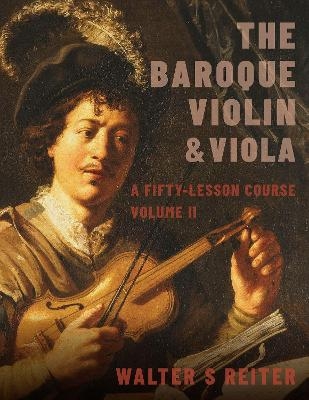
The Baroque Violin & Viola, vol. II
Oxford University Press Inc (Verlag)
978-0-19-752512-8 (ISBN)
In the early seventeenth century, enthusiasm for the violin swept across Europe--this was an instrument capable of bewitching virtuosity, with the power to express emotions in a way only before achieved with the human voice. With this new guide to the Baroque violin, and its close cousin, the Baroque viola, distinguished performer and pedagogue Walter Reiter puts this power into the hands of today's players. Through fifty lessons based on the Reiter's own highly-renowned course at The Royal Conservatory of the Hague, The Baroque Violin & Viola, Volume II provides a comprehensive exploration of the period's rich and varied repertoire.
The lessons in Volume II cover the early seventeenth-century Italian sonata, music of the French Baroque, the Galant style, and the sonatas of composers like Schmelzer, Biber, and Bach. Practical exercises are integrated into each lesson, and accompanied by rich video demonstrations on the book's companion website. Brought to life by Reiter's deep insight into key repertoire based on a lifetime of playing and teaching, The Baroque Violin & Viola, Volume II: A Fifty-Lesson Course will enhance performances of professional and amateur musicians alike.
Walter Reiter is internationally recognized as a leading Baroque violinist, leader and conductor. He has made countless recordings with both British and European Baroque orchestras as well as several highly acclaimed solo CDs. A devoted and experienced teacher of both modern and Baroque violin, he is currently Professor of Baroque Violin and Viola in the Royal Conservatory of The Hague in the Netherlands.
Foreword
Introductory quotes
Questions and Answers
Part Three
Approaching the Early Seventeenth Century Italian Sonata
Lesson Twenty-Four. Stepping Back in Time: Division Manuals 1535-1624. Ornamentation, Module Two
Divisions - Learning to Dare: Developing Basic Improvisational Skills - Sylvestro Ganassi's 'Fontegara' (Venice, 1535) - Studying Divisions from Ganassi's 'Fontegara' - Learning to Read Sixteenth and Seventeenth-century Music from Facsimiles - Note Values - Giovanni Bassano: 'Ricercate, passaggi et cadentie,' (Venice 1585) - Cadences - Aurelio Virgiliano: 'Regole Della Diminutione' (c 1600) - G. B. Spadi: 'Libro de passaggi ascendenti e descendenti' (Venice, 1624).
A Florentine Interlude. Towards 'The New Music:' from Plato to Caccini
Lesson Twenty-Five. The Noble Manner of Singing: Caccini's 'Le Nuove Musiche' (1602)
Passaggi - Three ways to Sing a Note - The Intonatio - Con Grazia - The Esclamazione - Transferring Caccini's 'Cor mio, deh! non languire' to the Violin - The Trillo and the Gruppo - Transferring the Vocal Trillo to the Violin - The Gruppo - Transferring the Vocal Gruppo to the Violin - Rhythmic Alteration - Transferring the Vocal Cascata to the Violin - Sprezzatura - Transferring Caccini's 'Deh, dove son fuggiti' to the Violin.
Lesson Twenty-Six. A Lesson from Francesco Rognoni Taeggio: Applying Vocal Technique to the Violin
El Portar della Voce - The Accento - The Tremolo - The Groppo - Del principiar sotto la nota - The Esclamatione - La Selva, Part Two - Francesco Rognoni's 'Way of slurring' -
Lesson Twenty-Seven. Giovanni Battista Fontana (1589 (?) - 1630) Sonata Terza
The Tactus - Reading this Sonata in the Original Notation Clefs - Rests - Coloration - Tempo Relationships and Proportional Notation.
Lesson Twenty-Eight. Dario Castello: Sonata Prima, for Soprano Solo
Lesson Twenty-Nine. Giovanni Antonio Pandolfi Mealli: Sonata Quarta Opus 4, La Biancuccia
'Stylus Phantasticus' - Musica Ficta.
Lesson Thirty: Ornamentation, Module Three, including Tables of Ornaments Derived from the Sonatas of Corelli and Babell
A Roman Interlude: Transforming Visual Gestures into Sound
Part Four
Church Militant: The Sonatas of Schmelzer and Biber
Lesson Thirty-One. Johann Heinrich Schmelzer: Sonata Quarta from 'Sonatae unarum fidium' (1664)
Lesson Thirty-Two. Heinrich Ignaz Franz von Biber: the Mystery Sonatas. Sonata No 1: the Annunciation
The Mystery Sonatas: an Introduction - Reference to the Texts.
Lesson Thirty-Three. Heinrich Ignaz Franz von Biber: the Mystery Sonatas. Sonata No 10: The Crucifixion
Scordatura - Symbolism and the Jesuits - The Rhetorical Fragments Described.
Part Five
Supreme Refinement of the Human Spirit
François Couperin and the Music of France
Interlude in Versailles: Approaching the Music of the French Baroque
The Sun King and the Culture of Versailles - The Social Status of the Violin in France.
Lesson Thirty-Four. The 'Concerts Royaux' of François Couperin. Ornamentation, Module Four
The 'Concerts Royaux,' an Introduction - Couperin's Agrémens, as found in the Septiéme Concert Royal - The Tremblement - The Pincé - The Port de voix - The Tierce de coulé - The comma (petit silence) - Notes inégales - Slurs - Pitch - Addendum: The Doublé - The Aspiration - The Suspension.
Lesson Thirty-Five. To Soothe the Sorrows of a King. François Couperin: Septiéme Concert Royal (I)
Movement One (no title) - Allemande, Gayement - Postscript: Dynamic and Rhythmical inégalité, a Personal View.
Lesson Thirty-Six. François Couperin: Septiéme Concert Royal (II)
Sarabande Grave - Georg Muffat on Lully's Bowings.
Lesson Thirty-Seven. François Couperin: Septiéme Concert Royal (III)
Fuguéte - Gavote - Siciliéne.
Part Six
Approaching the Galant
Lesson Thirty-Eight. Beyond 'Beautiful': Searching for Meaning in Music. Handel: Sonata in A Major
Beautiful Sights and Beautiful Sounds - Handel and Mattheson - Der Vollkommene Capellmeister - Identifying Affects in the Handel Sonata Movement - Punctuation.
Lesson Thirty-Nine. Into the Galant: Tartini, Telemann, Quantz and Zuccari. Ornamentation Module Five
Tartini: Grace notes - Trills - Vibrato (Tremolo) - The Turn - The Mordent - Cadences. Telemann's Methodical Sonatas. Telemann's Ornaments: Rising and falling appoggiaturas - Trills - Passing notes - Harmonising ornaments - Turns - Rhythmic variation - Ornamented Cadences - Tiratas. Quantz - A Lesson from the Master: Quantz's Notated Adagio - Zuccari.
Part Seven
J.S. Bach
Lesson Forty. A Brief History of Baroque Romanticism: Bach's 'Sei Solo'
Lesson Forty-One. Johann Sebastian Bach, Sonata I, BWV 1001. Adagio
Bach's Written-out Ornamentation - The Necessity of Illusion - A Controversial Note - Afterthought.
Lesson Forty-Two. Johann Sebastian Bach, Sonata I, BWV 1001. Fuga
A Note on Resonance
Lesson Forty-Three. Johann Sebastian Bach, Sonata I, BWV 1001. Siciliana
Hooked Bowings
Lesson Forty-Four. Johann Sebastian Bach, Sonata I, BWV 1001. Presto
Bach and Rhetoric - On Slow practice.
Lesson Forty-Five. Intonation in Bach's 'Sei Solo.'
The Training of the Ear - Intonation Analysis - Learning to hear quickly - The Training of the Left Hand - Playing Chords: the Left Hand
Lesson Forty-Six. Johann Sebastian Bach, Partita III in E Major, BWV 1006. Preludio
Interlude: Bach and the Influence of French Culture in the German Lands
Bach and Dance
Lesson Forty-Seven. Johann Sebastian Bach: Partita III in E Major, BWV 1006
Loure
Tempo and Bowings in Bach's Loure - Punctuation and Articulation in Dance Movements - Punctuation and Articulation in Bach's Loure - Ornamentation in Bach's Dances.
Lesson Forty-Eight. Johann Sebastian Bach. Partita III in E Major, BWV 1006. Gavotte en Rondeaux
Lesson Forty-Nine. Johann Sebastian Bach. Partita III in E Major, BWV 1006. Minuets I and II
Lesson Fifty. Johann Sebastian. Bach. Partita III in E Major, BWV 1006. Bourée and Giga
Notes to Lessons
Bibliography
Index
Acknowledgements
| Erscheinungsdatum | 20.10.2020 |
|---|---|
| Zusatzinfo | 191 music ex., 14 illustrations, 26 figures |
| Verlagsort | New York |
| Sprache | englisch |
| Maße | 274 x 213 mm |
| Gewicht | 957 g |
| Themenwelt | Kunst / Musik / Theater ► Musik ► Instrumentenkunde |
| Kunst / Musik / Theater ► Musik ► Klassik / Oper / Musical | |
| Kinder- / Jugendbuch ► Sachbücher ► Kunst / Musik | |
| ISBN-10 | 0-19-752512-1 / 0197525121 |
| ISBN-13 | 978-0-19-752512-8 / 9780197525128 |
| Zustand | Neuware |
| Haben Sie eine Frage zum Produkt? |
aus dem Bereich


